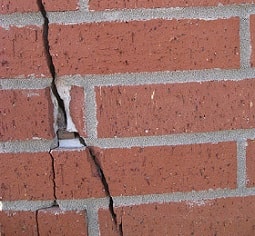
Sheetrock & Mortar Problems in OK
Cracks can be a huge problem in both the interior and exterior of the home. Although cracks may be more likely in older homes, they are still possible in new homes, especially if the newer home develops a foundation issue. Some common areas for cracks to form are the mortar between exterior bricks and the interior sheetrock. It is important to regularly examine both the interior and exterior of your home for the signs of foundation failure. If you notice any issues in your home that are suspicious of a foundation issue, contact Pierman Foundation Repair Services today.
 In the interior of the home, you can look for cracks in your sheetrock. These cracks can appear in the ceiling and the walls, and come in several different types:
In the interior of the home, you can look for cracks in your sheetrock. These cracks can appear in the ceiling and the walls, and come in several different types:
- Spiderweb cracks: Spiderweb patterned cracks in your sheetrock may be a sign of the natural settlement of your home, especially if you have an older home. If these cracks appear around doors or windows, however, they may be an indication of a foundation issue.
- Vertical cracks: Vertical cracks in the sheetrock walls in your home can mean that your home is suffering from foundation settlement. These cracks may extend the length of the ceiling and continue down the adjacent walls.
- Horizontal cracks: Horizontal cracks in your sheetrock walls are a sign that your foundation is heaving or settling. This can occur during harsh temperature changes or periods of extreme variance in the moisture content of the soil.
 Next, you can look at the exterior of your home, especially if you have brick or masonry. One of the most common places for cracks to form in the exterior of your home is in the mortar between bricks or masonry. The common types of mortar cracks are:
Next, you can look at the exterior of your home, especially if you have brick or masonry. One of the most common places for cracks to form in the exterior of your home is in the mortar between bricks or masonry. The common types of mortar cracks are:
- Vertical cracks: Much like in the sheetrock, vertical cracks in the mortar of your home indicate uneven foundation heaving or settling.
- Horizontal cracks: Horizontal cracks in the mortar are often an indication of foundation settlement, which can occur due to erosion, soil shrinkage, or poor soil compaction.
- Stair-step cracks: If there are stair-step shaped cracks in the mortar between the brick on your home, it could be a sign of settlement, especially if these cracks are larger than 1/16 inches or appear around doors or windows.
Solutions for Sheetrock and Mortar Cracks in Oklahoma Including Muskogee, OK
Since most sheetrock and mortar cracks are caused by foundation movement such as heaving or settlement, the most effective solution is to stabilize the foundation. This can be done in a few different ways: the installation of helical piers, the installation of steel push piers, or polyjacking. Steel piers and helical piers both anchor into the load bearing soils deep underground and support the weight of the structure to remove stress from the failing foundation and restore it to the proper position. The main difference between the piers is that helical piers are screwed into the ground, while steel piers are driven into the ground. Polyjacking is a method that involves the injection of an expanding polyurethane foam to fill voids and support lift the above foundation. These methods all stabilize the foundation to close any cracks that may have formed.
If you live in Oklahoma and need sheetrock or mortar repair, contact Pierman Foundation Repair Services today.
